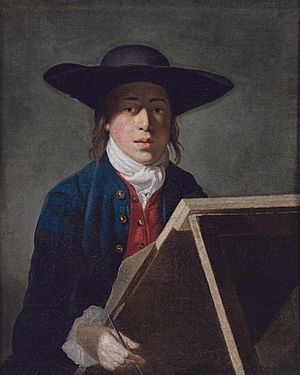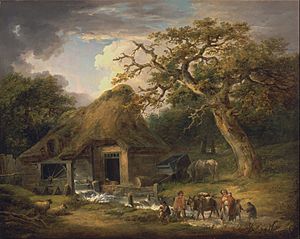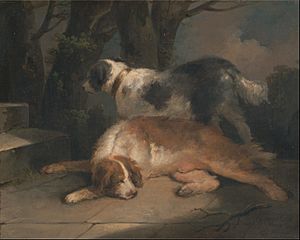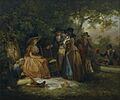George Morland facts for kids
Quick facts for kids
George Morland
|
|
|---|---|

George Morland (Henry Robert Morland, c. 1780)
|
|
| Born | 26 June 1763 London, England
|
| Died | 29 October 1804 (aged 41) Brighton, England
|
| Spouse(s) |
Anne Ward
(m. 1786) |
George Morland (born 26 June 1763 – died 29 October 1804) was a famous English painter. At first, his art was similar to Francis Wheatley's style. But after the 1790s, he developed his own unique way of painting.
His best paintings show scenes from the countryside. He often painted farms, hunting scenes, and people like gypsies. He also created beautiful landscapes that looked like paintings from the Dutch Golden Age. Many of his artworks were made to be turned into prints. These prints helped make his art very popular. He faced many financial challenges in his later years and passed away at the age of 41.
Contents
Biography
George Morland was born in London on 26 June 1763. His father, Henry Robert Morland, and grandfather, George Henry Morland, were also artists. George started drawing when he was only three years old. By the age of ten (1773), he was already showing his sketches at the Royal Academy. He continued to exhibit his art in different societies until 1780.
His father helped him develop his artistic skills. George copied many paintings, especially those by Dutch and Flemish artists. He even copied famous works like Fuseli's Nightmare and Reynolds's Garrick between Tragedy and Comedy. Before he was seventeen, George was already well-known for his talent. A great example of his early skill is the engraving The Angler's Repast, made by William Ward in 1780.
Around 1784, George decided to become an independent artist. He moved into a picture dealer's house. He worked very hard, painting many pictures. He also taught himself to play the violin. For a short time, he painted miniatures in Margate. In 1785, he visited France, where his artistic reputation was already known.
After returning to London, he lived near William Ward. This friendship led to George marrying Anne Ward (Nancy), William's sister, in July 1786. A month later, William Ward married George's sister, Maria. For a while, George seemed to settle down.
His art became very popular through engravings. These included 'Children Nutting' (1783) and 'Lass of Livingston' (1785). Around this time, he enjoyed visiting the Isle of Wight. There, he painted many coastal scenes. In 1786, he painted The Wreck of the Haswell. This painting shows the fear and despair of people caught in a shipwreck.
Later Life
After a few months, the two families living together separated. George moved to different places in London, including Camden Town. He continued to paint, but his personal life became more challenging. He eventually separated from his wife.
Around 1791, he painted his famous picture 'The Inside of a Stable'. This painting is now in the National Gallery. It is believed to show the stable of the White Lion Inn in Paddington. At this time, George was at the peak of his artistic ability. His paintings showed great skill in color and feeling. He continued to exhibit his work in 1793 and 1794.
George Morland's art was so popular that he could have lived comfortably from his earnings. Dealers often came to him, eager to buy his paintings. He produced an amazing amount of work. He could paint one or two pictures a day. Once, he painted a large landscape with six figures in just six hours! He often paid his bills with his paintings. These artworks were usually worth much more than the debt he was settling.
Career
From 1788 to 1792, over one hundred engravings were made from Morland's paintings. These included elegant scenes like 'A Visit to the Child at Home'. He also created charming pictures of children playing, such as 'Children Birdnesting' and 'Blind Man's Buff'.
Some of his popular works showed moral lessons, like 'The Fruits of early Industry and Economy' (1789) and 'The Effects of Extravagance and Idleness' (1794). He also painted subjects that touched on important social issues. These included 'The Slave Trade' (1791) and 'African Hospitality'. Five hundred copies of the 'Dancing Dogs' (1790) engraving sold in just a few weeks.
Over time, his elegant subjects changed to scenes of everyday life. He painted people in the countryside and by the coast, including fishermen. He also painted animals like horses, donkeys, dogs, pigs, and poultry. About 250 different engravings of his works were published during his lifetime.
Even though publishers made a lot of money from his art, George Morland faced increasing financial difficulties. He moved often to avoid his creditors. He lived in various places like Lambeth, Kensington, and Hackney. Once, in Hackney, people thought he was forging bank notes. His home was searched, but it was a mistake. The bank later gave him money for the trouble.
Dealers and innkeepers would often set up rooms for him to paint in. They would provide him with materials. He was incredibly productive. It is estimated that he painted around 4,000 pictures in his lifetime. For example, he painted 192 pictures for his brother alone between 1800 and 1804.
In November 1799, George Morland was arrested due to his debts. He was allowed to stay in special lodgings. In 1802, he was released under a new law for people in debt. However, his health was very poor. He suffered from palsy, which affected his left hand. Despite this, he continued to paint until his last days. He passed away on 27 October 1804, while dealing with financial issues. His wife died three days later, and they were buried together.
Works
Some of Morland's best paintings were created between 1790 and 1794. His picture The inside of a stable (now in Tate Britain, London) is considered a masterpiece. In the last eight years of his life, Morland produced about nine hundred paintings and over a thousand drawings.
He regularly showed his art at the Royal Academy from 1784 until 1804. One notable painting from 1788 was Execrable Human Traffic or the Affectionate Slaves. Two years later, he exhibited a companion painting showing Africans helping shipwrecked Europeans. These paintings were later made into prints and helped support the movement to end slavery.
Morland was a good friend of artist William Armfield Hobday (1771–1831), who painted a portrait of him. William Collins was also a student of Morland and later wrote a book about his life.
Images for kids
See also
 In Spanish: George Morland para niños
In Spanish: George Morland para niños
- English school of painting









